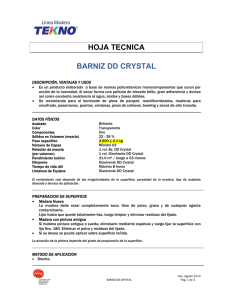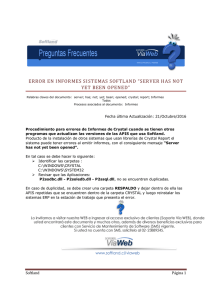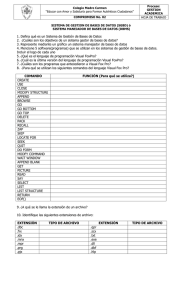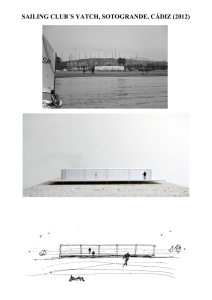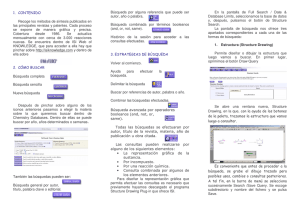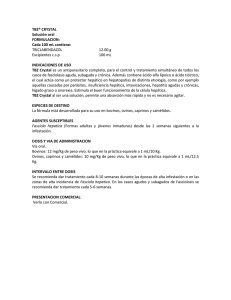The crystal structure of lead (11) indium (111)
Anuncio
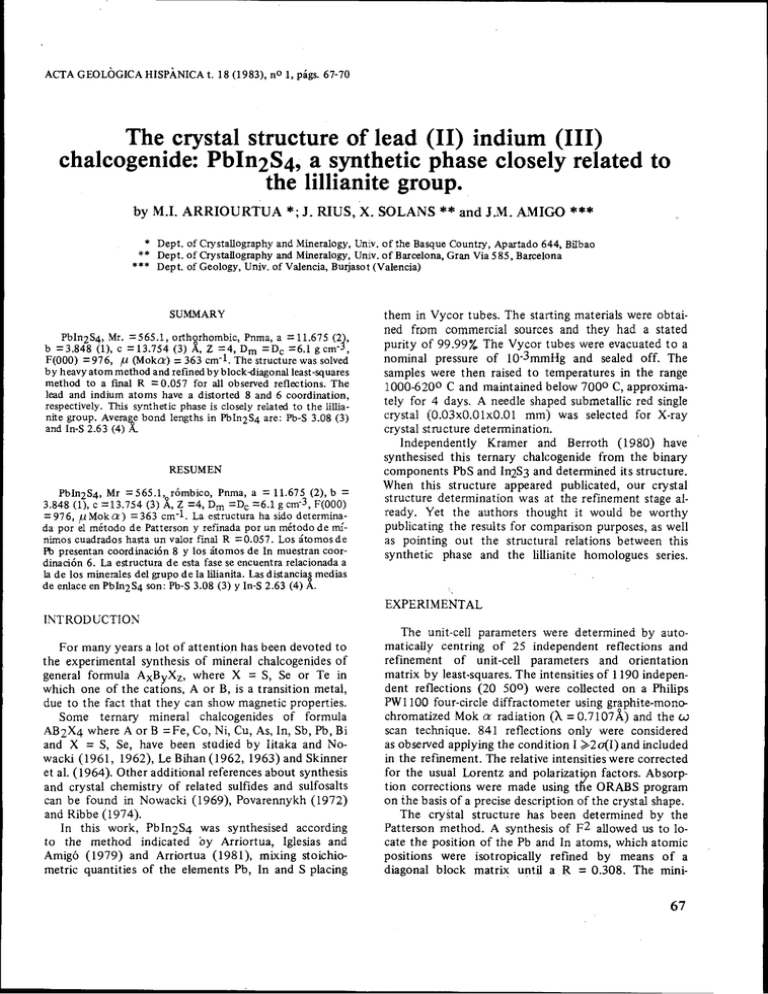
l
ACTA GEOLOGICA HISPANICA t. 1 8 (1983), no 1, págs. 67-70
The crystal structure of lead (11) indium (111)
chalcogenide: PbIn2S4, a synthetic phase closely related to
the lillianite group.
by M.I. ARRIOURTUA * ; J . RIUS, X. SBLANS ** and J.M. AMIGO
*
**
***
***
Dept. of Crystaliography and Mineralogy, Univ. of the Basque Country, Apartado 644, Bilbao
Dept. of Crystallography and Mineralogy, Un1.v. of Barcelona, Gran Via 5 85, Barcelona
~ e p t of
. Geology, niv v. of Valencia, ~ u j a s o (Valencia)
t
SUMMARY
PbInzSq, Mr. =565.1, orthorhombic, Pnma, a =
b ~ 3 . 8 4 8(l), c =13.754(3) A, Z = 4 , D m = D c = 611.675
. 1 g c m (215
- ,
F(000) ~ 9 7 6 ,,u (Moka) = 363 cm-l. The structure was solved
by heavy atom method and refined by blockdiagonal least-squares
method to a fmal R ~ 0 . 0 5 7for al1 observed reflections. The
lead and indium atoms have a distorted 8 and 6 coordination,
respectively. This synthetic phase is closely related to the lillianite group. Avera e bond lengths in PbIn2Sq are: Pb-S 3.08 (3)
and In-S 2.63 (4)
!k
RESUMEN
PbInzSq, Mr ~565.1,rómbico, Pnma, a = 11.675 (2), b =
3.848 (l), c =13.754 (3) A, Z =4, D, =Dc ~ 6 . g1 cm-3, F(000)
=976, p M o k a ) =363 cm-l. La estructura ha sido determinada por el método de Patterson y refinada por un método d e mínimos cuadrados hasta un valor final R ~ 0 . 0 5 7 .Los átomos d e
Pb presentan coordinación 8 y los átomos de In muestran coordinación 6. La estructura d e esta fase se encuentra relacionada a
la de los minerales del grupo d e la lilianita. Las distancia medias
de enlace en PbIn2Sq son: Pb-S 3.08 (3) y In-S 2.63 (4) .
them in Vycor tubes. The starting material5 were obtained fr~m~cornmercial
sources a i d they had a stated
purity of 99.99% The Vycor tubes were evacuated t o a
~ sealed off. The
nominal pressure of 1 0 - 3 m m ~and
samples were then raised t o temperatures in the range
:1000-6200 C and maintained below 7000 C, approximately for 4 days. A needle shaped submetallic red single
crystal (0.03x0.01x0.01 mm) was selected for X-ray
crystal structure determinatiori.
Independently Kramer and Berroth (1980) have
synthesised this ternary chalcogenide from the binary
components PbS and In2S3 and determined its structure.
When this structure appeared publicated, our crystal
structure determination was at the refinement stage already. Yet the authors thought it would be worthy
publicating the results for comparison purposes, as well
as pointing out the structural relations between this
synthetic phase and the liuianite homologues series.
1
EXPERIMENTAL
INTRODUCTION
For many years a lot of attention has been devoted t o
the experimental synthesis of mineral chalcogenides of
general formula AxByXz, where X = S, Se or Te in
which one of the cations, A or B, is a transition metal,
due to the fact that they can show magnetic properties.
Some ternary mineral chalcogenides of formula
AB2X4 where A or B =Fe, Co, Ni, Cu, As, In, Sb, Pb, Bi
and X = S, Se, have been stadied by Iitaka and Nowacki (1961, 1962), Le Bihan (1962, 1963) and Skinner
et al. (1964). Other additional references about synthesis
and crystal chemistry of related sulfides and sulfosalts
can be found in Nowacki (1969), Povarennykh (1972)
and Ribbe (1974).
In this work, PbIn2Sq was synthesised according
to the method indicated by Arriortua, Iglesias and
Amigó (1979) and Arriortua (1981), mixing stoichiometric quantities of the elements Pb, In and S placing
The unit-cell parameters were determined by automatically centring of 25 independent reflections and
refinement of unit-cell parameters and orientation
matrix by least-squares. The intensities of 1 190 independent reflections (20 500) were collected on a Philips
PW 1100 four-circle diffractometer using graphite-monochromatized Mok a radiation (A = 0.7107A) and the w
scan technique. 841 reflections only were considered
as observed applying the condition 1 3 2 4 1 ) and included
in the refinement. The relative intensities were corrected
for the usual Lorentz and polarizati n factors. Absorption corrections were made using t?f e ORABS program
on the basis of a precise description of the crystal shape.
The crystal structure has been determined by the
Patterson method. A synthesis of ~2 allowed us to locate the position of the Pb arid In atoms, which atomic
positions were isotropicaliy refined by means of a
diagonal block matrix until a R = 0.308. The mini-
X
Y
Z
Interatornic
Ueq
Central atom
Symmetry operation code used in Table 11 and subsequent Tables:
i
ii
iii
N
v
vi
vii
= 1 + x , y,?:
=1+x,-1+y,z
=x, l + y, zi
=x,-l+y,z
= - l + x , lf y,z
=-l+x,y,z
= l-x, 2-y, -z
viii
ix
x
xi
xii
xiii
XN
distances
2.70
2.70
2.53
2.62
2.62
2.62
(6;)
Angles with central atom (O)
! ( 1 - S 1
!S (3)-.--S (319
F'b-S(1)
-S(2)
-S(3)
-S(4)
-S(llV)
-S (31V1
-S(4!V)
-(2Xlv)
Mean: 3.0886;
S (4)-. --(41v)
Mean: '78.50
S (1)-.-S (2X")
-S (4)
S( 2 ) - 3
S (3)-.-S ( 2 9
S (2)-.-S (4")
Mean: '71.30
79.6
76.6
79.2
69.8
68.6
71.5
73.5
72.9
+
+
+
Table 2. EightCoordination for F'b atom
interatomic
Interatomic
Central atom,
In(1) -S (1:)
-S(lll)..
-S(lVl")
-~(3Xf)
-S(2X")
-S(3X")
Mean: 2 6 3 1
(6;)
=: 1-x, 1-y, -Z
='-x, 2-y, -z
==-x, l-y, -z
==0.5+ , 1.5-y, 0.5-z
=: 0.5 x, 0.5 -y, 0.5 -Z
==-0.5
X, 1.5-y, 0.5-z
==-0.5
x, 0.5-y, 0.5-z
Table 1. Atomic coordinates ( ~ 1 0 5 arid
) equivalent thermal parameter coeficients. (Leq = ( 6 2 ) - l ~ ~ ~ a ~ a ~ )
/
distances
Aig!es with central atom (O)
S (l!)-.-S (3'y)
173
173
S ( 1 - S (3x1),,
S(I.Vu1)-.-S (2Xu) 161°
Mean: 1690
S(1.u)-.-S (1~")
83.9
-s(~x!),
82.8
~(3Xi)-.-s(lVy)
102.5
-S(ZXu)
90.3
S(I.~)-.-S(I"?..
90.9
-S(lV?)
83.9
-S(2X!)
82.8
-S(3'1)
86.09
s(~x"-. -s(luj.
86.09
-S(lv?)
102.5
-S(2'!)
90.3
-S(3X')
94.5
Mean: 89.8O
Table 3. Six-~oor~dination
for In (1) atom
Central atom
In (2) - S (2)
-S(4)..
- S (2l:)
- S( 4 9
- S (4"'")
Mean: 2.62
distances (A)
259
2.60
2.59
2.65
2.65
Angles with ce,ntral a
S (2)..-. --.S
,.
S ( 2 u ) --.- S (4"'")
S (4) -.- S (3'1)
Mean: 176.50 ...
S(2)-.-S(2y)
-S(3Xl)
-S(4vlu)
S (4)...
S( 3 ~ ~
- S (4) ,
s(~v")-.-s(~x~)
-S(4).
S(4Vii)-.-S(2?)
- S (3x1)
- S (4).,,
-S(4V")
Mean: 900
S (2")
Table 4. SixCoordination for In (2) atom
-.-
t o (O)
177.1
177.1
175.4
96.1
91
85.4
92
) 91
92
91.05
85.4
85.4
91.5
85.4
93.1
mized function was w 1 IFol- lFcl 12, where w = (a+ ' 1 ~
lb I F % ) - being
~
a and b the wheight of Cruickshank
(1965). A Fourier synthesis revealed in this moment the
positions of the S atoms. During the firsi part of the
refinement process, isotropic thermal parameters were
used and the R index dropped t o the value of 0.106. At
this moment, an anisotropic refinement using the Fo
obtained after having corrected absorption effects was
carried out. The final R was 0.057.
Lists of structure factors and anisotropic thermal
parameters are avaiiable upon request from the "Departamento de Cristalografía y Mineralogía de la Universidad
del Pais Vasco".
+
~ 1 then the resultant crystal structure will correspond
t o the distorted one of the l , l L lillianite (Pb3Bi2Sg)
homologue, where every superscript of L expresses the
number of octahedra in the chain of octaedra, running
diagonally across an individual "galena-like" layer and
paraílel to [Olllpbs (Makovicky and KarupMoller,
1977), and, therefore, the two alternating layers of
"galena-like" structure parallel t o (131)pbs are related
by a "pseudomirror plane" normal t o the direction (see
figure 1). The sites with bicapped trigonal prismatic
coordination [ 6 + 21 on this 'hirro-plane" are occupied
by the Pb atoms.
The Pb-S distances for this coordination are given
in Table 2, the values ranging between 3.008(3) and
3.251(5)A (average: 3.08(3)A). All the S atoms in the
structure are involved in the Pb coordination, each one
being bonded t o two Pb atorns and t o three In atoms.
The In atoms are at the centers of the slightly distorted octahedra forming the lillianite-like octahedral portions (Tables 3 and 4). Unlike the lillianite homologues,
these portions do not form two alternating layers of
"galena-like" structure in Pbln2Sq. The orientation of
these portions is illustrated in figure 1. The @S mean
distance is 2.63(4)A (range: 2.528(4)-2.702(3)A) and the
S-In-S mean angle 90 (1)o (range: 82.3(1)-96.2 (1)o).
Other related natural chalcogenides belonging t o the
lillianite homologous series are listed in Table 5.
There is no direct correlation between this crystal
structure and the observed structure types of AB2X4
compounds given by Iglesias and Steinfink (1973).
Mineral:
Formula:
Figure 1 .- The crystal structure of PbIn2Sq. In order of decreasing size the circles indicate S, Pb. In. this (010) structure projection along the " 4 1 penod, ampty and fuli circles indicate atoms
at two discrete structure levels, aprox. 2 i apart. Ruled shading:
"liliianite-like octahedral layers"; stippled: bicapped trigonal
coordination.
Lillianitel)
Pb3Bi2S6
Space group: Bbmm
Hopologue: 4 9 4 ~
0urayite2)
~g~ &pb15
Synth. ~ h a s e 3 )
Pb1n2s;
Bi20.5 S52
Bbmm
11,ll~
Pnma
l , l ~
1) Takagi & Takéuchi (1972)
2) Makovicky & Karup-Mdller (1977b)
DISCUSSION OF THE STRUCTURE
Table 1 gives the final atomic parameters of PbIn2Sq
and figure 1 shows a projection of its crystal structure
on the plane (010).
The chernical composition derived from the crystal
structure determination of this low-temperature form
is in perfect agreement with the elemental analysis of
the compound. The structure determination also allows
t o confirm the ordered state of this phase i.e. the metal
sites are fully occupied and no partial substitution
between Pb=In could be detected.
The crystal structure of this synthetic phase may be
regarded as an incomplete lillianite homologue. If the
y coordinate of the In (1) atom is changed by 112 b,
3) This work
* for comparison with the lillianite homologues, the cell parameters are interchanged.
Table 5. Crystal data for PbIn2S4 and for two lillianite h o m e
logues.
ACKNOW LEDGEMENTS
We thak Prof. U. Thewalt and Dr. T. Debaerdemaeker of the University of Ulm for assistance with the
intensity measurements on the Phiiips diffractometer.
Thanks are also extended t o the Alexander von Humboldt Foundation awarding to one of us (J.M.A.) during
his stay in Ulm.
REPERENCES
ARRIORTUA, M.I., IGLESIAS, J.E. and AMIGO, J.M., 1979:
"Preparación 11 estudio mediante difracción d e rayos X d e un
sulfuio ternaho d e plomo e indio (F'bIn2S4)". ~ nQuím,
:
75:
787-792.
ARRIORTUA, M.I., 1981 : Ciistaloqu{rnica d e algunos calcogenuros ternarios d e plomo e indio. Tesis doctoral. Universidad
del País Vasco, 199 pp.
CRUICKSHANK, D.W.J. 1965,: "Errors in least-squares methods", in Computing methods in Crystailography, ed. J.S.
Roilet, 112, 116. Oxford. Pergamori Press.
IGLESIAS, J. E. and STEINFINK, H., 1973: "crystal Chemistry
of AB2X4 (X =S, Se, Te) Compounids". J. Solid State Chem.,
6 : 119-125.
IITAKA, Y. and NOWACKI, W. 1961: "A refinement of the
pseudo crystal structure of scle~oclasa, PbAs2S4". Acta
Cryst. 14: 1291-1292.
IITAKA, Y. and NOWACKI, W., 1962: "A redennination of
the crystal structure of galen~bir~mutite,PbBi2Sq". Acta
Cryst. 15: 691698.
KRAMER, V. anid BERROTH, K. 1980: "Phase investigations
in the system ]%S-IqS3 and the crystal structures ofPbIn2Sq
and Pb6InloS:21". Mat Res. Bu11 15 : 299-308.
LE BIHAN, M. Th., 1962: "Etude sti'ucturale de quelques sulfares de ploml~et d'arsenic naturelir du Gisement d e Binn".
Bull. Soc. f r a y . Mineral. Cristallogr. 85 : 1547.
LE BIHAN, M. Th., 1963: "Etude structurale de quelques
sulfures de plomb et d'arsenic naturi:ls du Gisement deBinn".
Mineral. Soc. Almer., Spec. Pap. 1: 149-152.
MAKOVICKY, E. and KARUP-MQLLER, S. 1977a: "Chemystry and crystaliography of the liliianite homologous series.
Part 1. General properties and defiiitions". A! Jb. Miner.
Abh. 130: 264-287.
MAKOVICKY, E. and KARUP-MqLLER, S., 1977b: "Chemystry
and crystallography of the liilianite, homologous series. Part
11. Definition of new minerals: eskimof e, vikingite, ourayite
and treasurite. Redefiition of schirmerite and new data on
the liilianitegustative solid-solution series". N. Jb. Miner.
Abh., 131: 56-82.
MAKOVICKY, E., 1981: "The building principies and claesificat ion of bismuth-lead sulphosalt s and related compounde".
Fortschr. Miner. 59: 137-190.
NIIZEKI, N. and BUERGER, M.J., 1957: "Thecrystal structureofjamesonite, FePbqSbgS14': 2. Kristallog. 109: 161-183.
NOWACKI, W. 1969: "Zur Klassfikationi und Kristallchemie
der Sulfosalze". Schweiz. Mineral. Petrog.. Mitt. 49: 109-156.
POV AR E NNY CK, A.S., 1972 : Crystal Chemical Clossificat ion
o f Minerals, New York-London. Plenum Press. Vol 1, pp.
119-130,217-266.
RIBBE, P.H. (Editor), 1974: Sulfde Mineralogy. Short Course
Notes. Mineralogical Society of America, 262p.
SKINNER, B.J. ERD, R.C. and GRYMALDI, F.S., 1964: 'Greigite, the thio-spinel of iron; a new mineral". Am. Mineral.
40: 543-555.
TAKAGI, J. and TAKEUCHI, Y., 1972: "The crystal structure
of lillianite". Acta O y s t . B28: 649-651.
Recibido, abril 1981
Revisado, abril 1982
ACTA GEOLOGICA HISPANICA
Norma:; a los colaboradores
Acta Geológica Hispánica es una revista científica dedicada a la publicación de trabajos de Ciencias de la Tierra.
Todos los artículos que se sometan para publicación en
Acta Geológica Hispánica deberán ser examinados por
miembros del Consejo de Redacción, el cual podrá
proponer modificaciones a los autores y aconsejará al
Consejo de Dirección sobre la conveniencia o n o de qiie
se publiquen los artículos.
Es de interés de la dirección de la revista fomentar la
discusión cientifica sobre trabajos publicados en la misma.
En el caso de trabajos de discusión se concedera derecho de
replica a los autores del trabajo en discusión. previa a la
publicación del mismo.
la paleogeografia del Cretacico inferior)). Acta Geol.
Hispánica, 13 (3): 73-78
iibro
MELENDLZ, B. 1971 : Fichero de Paleontologia Estratigráfica. Madrid, Ed. Paraninfo, 80 p.
SAN MIGUEL D E LA CAMARA, M. 1955: Mapa geológico de España esc. 1:50.000. Explicación de la Hoja
n." 403, Maderuelo, 84 p.
articulo dentro de otra obra
CHOUKROUNNE, P. y SEGURET, M. 1973: aTectonics of the Pyrenees)) in D. Jong and R. Shulten, eds.
Cravity and Tectonics, pp. 141-156, New York, John
Wiley & Sons.
Testo
Los manuscritos se presentarán en original y 2 copias
mecanografiados a doble espacio, en papel tamaño DINA-4. dejando amplios márgenes para facilitar las correcciones.
En la primera página figurará únicamente el titulo del
trabajo. autor o autores. dirección profesional de los autores y cualquier nota pie de pagina que haga referencia ad
titulo.
En la segunda página figurará un corto resumen de u11
máximo de 40 palabras en el mismo idioma que el articulo ,y
otro resumen, que puede ser más largo, preferentemente en
inglés o en todo caso en francés o aleman.
En el texto para los titulos de las divisiones o apartados
principales se utilizarán MAYL'SCULAS (doble subrayado
en el manuscrito) y cursivas (subrayado sencillo en el manuscrito) para los titulos de los subapartados, que en caso di:
necesidad podran numerarse.
Los nombres de las especies paleontológicas en el manuscrito deberan figurar como en el siguiente ejemplo: Orbitolina lotzei, SILVESTRI, Alveolina sp.
Ilustración
El tamaño máximo de las ilustraciones será el del formato
de una pagina de la revista (17 x 21 cm).
En el caso de dibujos a pluma pueden entregarse los originales sobre papel de dibujo blanco o transparente de suficiente calidad.
En el caso de fotografías, deberán procurar agruparse
todas las del articulo en una lámina unica. En el caso de
requerirse más de una lamina fotografica entera (17 x
x 21 cm) podrán ser objeto de un recargo para paliar los
sobrecargos de publicación.
Cuando por su naturaleza las ilustraciones requieran escala ésta deberá ser gráfica e incluirse en la ilustración.
Biblio,~rafia
Las referencias a citas bibliográficas deberán ser las estrictamente necesarias.
En el texto dichas citas deberán contener el nombre del
autor seguido del año de publicación. En el caso de dos
autores deberán figurar los dos, en el caso de mas di:
dos autores solo figurará el orimero de ellos seguido de I i i
expresión «et al.» del año'de publicación. ~j.. Melende;!
(1971) o (Melendez. 1971). Choukrounne y Seguret (1973).
(Bada et al., 1978).
En la lista de referencias bibliográficas al final del articulo. se incluirán únicatnente las citadas en el texto. ordenadas alfabeticamente por nombre de autores.
En estas citas deberá figurar el nombre completo del
autor o autores. el año de publicación. el titulo del libro o
articulo. el nombre de la revista, las paginas. según los modelos de los ejemplares que se citan a continuación:
Correspondencia
Toda la correspondencia referente a Acta Geológica Hispánica deberá dirigirse a la secretaria de la revista:
D.a Tonia Hernández
Instituto Jaime Almera del CSIC
Alcarria, s/n. Barcelona (28)
;
articiilos de revista
ESTEBAN. M. y ROBLES OROZCO. S. 1976: «Sobre
Pruebas
Se entregará un juego de pruebas de imprenta a los autores para que corrijan los posibles errores tipográficos. En
las pruebas no podrán introducirse modificaciones o añadidos respecto a los originales sin previa autorización de la
dirección de la revista. Las pruebas corregidas deberán devolverse en el plazo máximo de 15 dias.
Derechos de autor
El CSIC como editor de la revista se reserva los derechos
de propiedad para la reproducción total o parcial de los
materiales publicados en Acta Geológica Hispánica.
En el caso de reproducciones de materiales que estén sujetos a derechos de autor. estos derechos asi como la responsabilidad de su obtención correrán a cargo de los autores de
los trabajos.
La dirección de la revista se reserva el derecho a negarse
a publicar trabajos cuando existieran dudas razonables
sobre los derechos de propiedad de materiales previamente
publicados.

